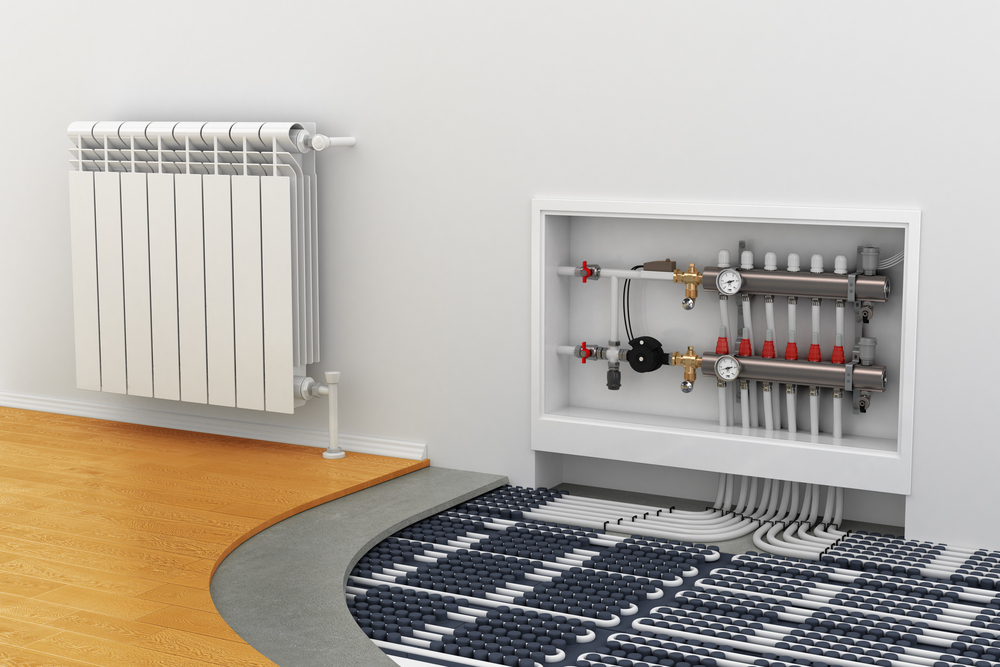Radiant Floor Heating Design & Installation
Want in-floor heating in a new house you’re investing in? Do you want your gas boiler or ground-source heat pump to have more heating efficiency? Do you want to reduce the amount of air pollutants in the air and thereby enhance occupant health? Discover the advantages of hydronic radiant floor heating systems in terms of comfort and efficiency!
Meridian Home Services is a locally owned mechanical company run by veterans that specializes in all forms of heating technology and provides cutting-edge installation, maintenance, and repair services for heating systems. All kinds and forms of radiant heating technology may be expertly designed, sized, and installed by our team since they have the hydronic understanding and practical experience needed. Get in touch with our solutions adviser right now to learn more about the comfort and great value of radiant floor heating choices.
Meridian Home Services Delivers Best-in-class Radiant Heated floors, Walls and Ceilings:
- Gas combustion analysis and tune-up
- Heating system preventive maintenance
- Heating equipment safety inspections
- Radiant heated floor installation
- Gas combi-boiler installation, replacement, and upgrades
- Gas boiler installation, replacement, and upgrades
- Ductless mini split heat pump installation, replacement, and upgrades
- Ground-source heat pump (GSHP) installation, replacement and upgrades
- Air-source heat pump (ASHP) installation, replacement and upgrades
- Electric air-handler installation, replacement, and upgrades
- Gas furnace installation, replacement, and upgrades

Foremost Benefits of Heated Floor Installation or Upgrades:
- Special winter pricing and preferential rates are provided to all-electric houses (available by most electric providers)
- Lower utility expenses as a result of the highly efficient heat source and hydronic distribution’s combined energy savings
- Considerable power savings — fan motors may use 90% less energy than hydronic circulator pumps.
- Less expensive heat distribution technique—water has 3,500 times the heat capacity of air.
- Radiant heating systems have been effectively used for over a century, making them an established technology.
- Compatible with a range of heat sources, gas boilers or water-to-water geothermal heat pumps are recommended.
- Tubing is hidden behind surfaces; it never obstructs furniture arrangement or detracts from interior design.
- Virtually silent operation (no fan motor forcing hot air via ducting) for a quieter living environment
- Safer operation: Containing dangerous air contaminants enhances indoor air quality and occupant health.
- Reduces temperature variations and areas of warmth and cold – (Evenly distributes heat throughout the house)
- Exceeds all expectations for winter comfort—especially in houses with tile, stone, and wood flooring.
Hydronic Heating Systems – Did You Know
Conduction, convection, or radiation are the three ways that heat transfers from warmer to colder things, according to the University of Wisconsin. These physical principles govern the operation of heating and cooling systems. When heat transfers directly from one item to another through a solid, this process is known as conduction. Placing a solid pan on a hot stovetop and allowing heat to flow directly from the cooktop to the pan is a frequent example of conduction. Convective heat transfer occurs between gases and liquids. Heat is transmitted from the warmer fluid to the colder surroundings as hot air or water moves from one place to another. Conventional heating and cooling systems mostly use convection.
In conclusion, radiation happens by electromagnetic waves; nevertheless, it doesn’t need any substance to move heat from one place to another, unlike convection and conduction. The heat experienced while standing directly in the sun is the most well-known example. The sole method of heat transmission used by conventional gas furnaces, air conditioners, and even heat pumps is convection. Utilizing all three modes of heat transmission, hydronic heating systems—such as heated floors—achieve far greater energy efficiency, provide improved comfort, and significantly enhance heat transfer. For frigid areas, hydronic floor systems are the most economical radiant heating method, according to the US Department of Energy (DOE).
A typical comfort issue with packaged heat pumps, air handlers, and conventional gas furnaces is temperature stratification. Convective processes cause stratification in air, which results in a discernible temperature differential in a space as warmer air rises to the roof and cooler air tends to sink to the floor. Radiant heat systems provide optimal comfort since they use all three heat transmission methods, meaning that air stratification is minimal and almost never noticeable to occupants. Furthermore, hard surfaces in a house, like stone, tile, and hardwood, create a conductive medium that transfers heat to the feet, giving the impression of coziness.
Through better temperature and humidity management, radiant heating systems have been shown to favorably contribute to enhanced indoor air quality, according to research published in the Sustainable Energy Technologies and Assessments Journal. Improvements in temperature are probably due to more uniform heat distribution across each room and less air temperature stratification. Numerous studies have shown how temperature and humidity affect health by facilitating the development and spread of viruses, mites, mold, mildew, and other disease-causing organisms. Better temperature and humidity control are provided by radiant heating systems, enhancing the indoor air quality of living spaces.
